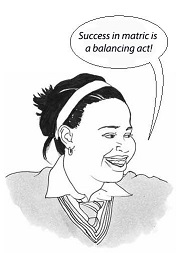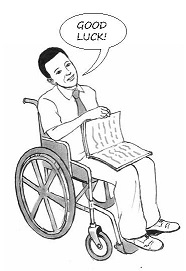In preparing for your final exams work through as many past examination papers as you can. Remember, your success in the final exam will depend on how much extra time you put into preparing.
Top 10 study tips
 |
- Have all your materials ready before you begin studying – pencils, pens, highlighters, paper, etc.
- Be positive. Make sure your brain holds onto the information you are learning by reminding yourself how important it is to remember the work and get the marks.
- Take a walk outside. A change of scenery will stimulate your learning. You’ll be surprised at how much more you take in after being outside in the fresh air.
- Break up your learning sections into manageable parts. Trying to learn too much at one time will only result in a tired, unfocused and anxious brain.
- Keep your study sessions short but effective and reward yourself with short, constructive breaks.
- Teach your concepts to anyone who will listen. It might feel strange at first, but it is definitely worth reading your revision notes aloud.
- Your brain learns well with colours and pictures. Try to use them whenever you can.
- Be confident with the learning areas you know well and focus your brain energy on the sections that you find more difficult to take in.
- Repetition is the key to retaining information you have to learn. Keep going – don’t give up!
- Sleeping at least 8 hours every night, eating properly and drinking plenty of water are all important things you need to do for your brain. Studying for exams is like strenuous exercise, so you must be physically prepared.
|
Study skills to boost your learning
|
Mobile notes
Mobile notes are excellent tools for learning all the key concepts in the study guide. Mobile notes are easy to make and you can take them with you wherever you go:
- Fold a blank piece of paper in half. Fold it in half again. Fold it again.
- Open the paper. It will now be divided into 8 parts.
- Cut or tear neatly along the folded lines.
- On one side of each of these 8 bits of paper, write the basic concept.
- On the other side, write the meaning or the explanation of the basic concept.
- Use different colours and add pictures to help you remember.
- Take these mobile notes with you wherever you go and look at them whenever you can.
- As you learn, place the cards in 3 different piles:
- I know this information well.
- I’m getting there.
- I need more practice.
- The more you learn them, the better you will remember them.
|
 |
 |
Mnemonics
A mnemonic code is a useful technique for learning information that is difficult to remember. This is an example of a word mnemonic using the word BALANCE where each letter of the word stands for something else:
B – Best – doing your best is more important than being the best.
A – Attitude – always have a positive attitude.
L – Load – spread the load so you don’t leave everything to the last minute. Use a study
timetable to plan.
A – Attention – pay attention to detail. Only answer what is required.
N – Never give up! Try, try and try again!
C – Calm – stay calm even when the questions seem difficult.
E – Early – sleep early the night before your exam. If you prepare well you will not need
to cram the night before.
Mnemonics are code information and make it easier to remember. The more creative you are and the more you link your ‘codes’ to familiar things, the more helpful your mnemonics will be.
|
Mind maps
Mind maps work because they show information that we have to learn in the same way that our brains ‘see’ information. As you study, add pictures to each of the branches to help you remember the content. Make your own mind maps as you finish each section.

How to make your own mind maps:
- Turn your paper sideways so your brain has space to spread out in all directions.
- Decide on a name for your mind map that summarises the information you are going to put on it.
- Write the name in the middle and draw a circle, bubble or picture around it.
- Write only key words on your branches, not whole sentences. Keep it short and simple.
- Each branch should show a different idea. Use a different colour for each idea. Connect the information that belongs together. This will help build your understanding of the learning areas.
- Have fun adding pictures wherever you can. It does not matter if you can’t draw well.
On the day of the exam
 |
- Make sure you have all the necessary stationery for your exam, i.e. pens, pencils, eraser and calculator (with new batteries). Make sure you bring your ID document and examination admission letter.
- Arrive on time, at least one hour before the start of the exam.
- Go to the toilet before entering the exam room. You don’t want to waste valuable time going to the toilet during the exam.
- Use the 10 minutes reading time to read the instructions carefully. This helps to ‘open’ the information in your brain. All questions are compulsory, unless indicated otherwise, but you do not have to answer them in order. Start with the question you think is the easiest to get the flow going.
- Break the questions down to make sure you understand what is being asked. If you don’t answer the question properly you won’t get any marks for it. Look for the key words in the question to know how to answer it.
- Try all the questions. Each question has some easy marks in it so make sure that you do all the questions in the exam.
- Never panic, even if the question seems difficult at first. It will be linked to something you have covered. Find the connection.
- Manage your time properly. Don’t waste time on questions you are unsure of. Move on and come back if time allows.
- Check weighting – how many marks have been allocated for your answer? Do not give more or less information than is required.
- Write big and bold and clearly. You will get more marks if the marker can read your answer clearly.
|
Question words to help you answer questions
It is important to look for the question words (the words that tell you what to do) to correctly understand what the examiner is asking. Use the words in the following table as a guide when answering questions.
|
Question word
|
What is required of you
|
|
Analyse
|
Separate, examine and interpret
|
|
Classify
|
Divide into groups or types so that things that are similar, are in the same group
|
|
Comment
|
Write generally about
|
|
Compare
|
Point out or show both similarities or differences
|
|
Define
|
Give a clear meaning
|
|
Describe
|
List the main characteristics of something
|
|
Discuss
|
Consider all information and reach a conclusion
|
|
Evaluate
|
Express an opinion based on your findings
|
|
Explain
|
Make clear, interpret and spell out
|
|
Forecast
|
Say what you think will happen in the future
|
|
Give/provide
|
Write down only facts
|
|
Identify
|
Name the essential characteristics
|
|
Interpret
|
Give the intended meaning of
|
|
List
|
Write a list of items
|
|
Mention
|
Refer to relevant points
|
|
Name
|
State something – give, identify or mention
|
|
State
|
Write down information without discussion
|
|
Suggest
|
Offer an explanation or solution
|